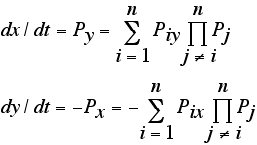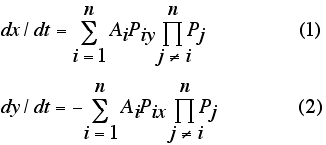
Consider the flow in R
2 defined by the solutions to the differential equations
which may also be written as

The local and global properties of the flow are traditionally arrived at by studying explicit solutions to the initial value problem and/or by studying local and/or global properties of the functions f and g.
In the simplest nontrivial case, where f and g are homogeneous linear functions of x and y, the system is generally written as

The topologically distinct flows defined by this simple system can be classified using the properties of the eigenvalues and eigenvectors of the (constant) coefficient matrix A. When the eigenvalues are real and distinct, the eigenvectors are in the directions of the separatrices of the system and the eigenvalues determine the rate of the flow on the separatrices. The separatrices themselves are straight lines through the origin.
In this document I propose a different approach to studying the properties of class of flows in R

For the sake of simplicity let us assume that

has P(x,y) = c as its general solution. If we generalize this system to

where not all of the Ai's are equal, then it is easy to see that P(x,y) = 0 is a solution to the new system, that is, the n components of P are among the solution curves to equations (1) and (2). Equations (1) and (2) constitute the least complex (lowest degree) nontrivial system for which P(x,y) = 0 is a solution. I call the system of equations given by (1) and (2) the master equation. Flows given by the master equation are generated by P(x,y). The irreducible components of P(x,y) are called the generators of the flow.
The non zero constant coefficients, Ai, in the master equation are called the global rates. They are related to another set of parameters

called the local rates. The relationship between the global rates and the local rates, in the case that each Pi is a linear function, are given by

where ci and bi are real but ai and bi may be real or complex, is defined by

It should be noted that in the more general case where P(x,y) is not algebraic, the components of P(x,y) are still solutions to equations (1) and (2). Furthermore, when all of the Ais equal 1, equations (1) and (2) become a Hamiltonian system.
Examples of AGFs are given in sample galleries: AGFExamples, TwoComplexLines, QuasiHamiltonian, AGFEMapExs, AGFFractals and AGFs&Mandelbrot.
In 1973 I wrote a book called "Algebraically Generated Flows." At that time access to computers that could do fast graphics was essentially nonexistent. Interesting AGFs are highly nonlinear so they are difficult to study without a computer. Consequently I never tried to publish the book. In 2000 I started to write OdeFactory to study AGFs. The program was expanded to include traditional forms of odes. I scanned the manuscript of the book to pdf files and put it on the web - in case anyone is interested in AGFs.
Here are the links to the pdf files:
TitlePage/Preface/TOC: the title page, the preface and the table of contents.
Chapter1: "Algebraically Generated Flows," pages 1 through 37.
Chapter2: "Real Linear Generators," pages 38 through 80.
Chapter3: "Limit Flows," pages 81 through 109.
Chapter4: "Modifications of the Master Equation," pages 110 through 131.
Chapter5: "Complex Linear Generators," pages 132 through 168.
Chapter6: "Real and Complex Linear Generators," pages 169 through 215.
Chapter7: "Further Conclusions and Some Problems for Future Research," pages 216 through 253.
References: a list of references used in writing the book, pages 286 through 292.
Notation and Index: a list of notation used in the book plus the index for the book, pages 293 through 297.
The 273 line program was written in BASIC and was executed on a remote timesharing machine connected via a telephone line. The input/output device was a teletype with a paper tape for storing programs and a long roll of 8.5 inch paper. The right hand sides of odes were entered directly into the program. The graphics output consisted of letters and digits printed at rows and columns locations, acting like really big "pixels," on the long roll of paper.
A Sample run of the program is shown on page 281. It is the R2 view of figure 3.3 on page 89 of the book. Bring up gallery AGFExamples in OdeFactory and select the system. Switch to the R2+ view to see figure 3.3 on page 89 reproduced - about 40 years later.
The pdf files total 105 MB.The page numbers in the index are for the entire book so to find a page you need to find the correct chapter then scroll through pages until you find the desired page of the book.